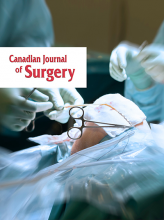Over the past 2 years, the national Task Force on the Future of General Surgery has grappled with questions related to the future configuration of the discipline. The goal is to ensure training that optimally prepares surgeons for practice in the full range of settings where general surgeons work in Canada, while national standards in surgical care are maintained and technical expertise is promoted. Their recommendations, available online in the Task Force’s final report, set an international precedent for a tailored approach to general surgery residency training.1 In this commentary, we look to the past for the context in which the task force undertook its work.
A look back
The configuration of general surgery in Canada dates back to an earlier era of medical practice. The history of this discipline is intertwined with the history of specialization in both medicine and surgery, the earliest instances of which relate to dentistry. In the late 19th century, dentists separated from medicine by setting up dental regulatory bodies in parallel to those in medicine. Despite this separation, dental students continued to require an abbreviated course in basic medical sciences before undertaking clinical dental training. In contrast, physicians who at the time specialized in the care of the eye and ear, known as oculists, remained within the jurisdiction of medicine. Training and specialized medical or surgical practice remained a matter of personal choice. Many Canadian doctors, especially those who wished to be surgeons, travelled to Britain for training and certification. In 1913, 68 Canadian surgeons joined colleagues in the United States to found the American College of Surgeons to promote continuing education of surgeons in practice, a role it maintains today.2 Upon its creation in 1929, the Royal College of Physicians and Surgeons of Canada recognized only 2 disciplines: surgery, represented by the colour red, and medicine, represented by the colour purple. Examination requirements drove the development of training programs. Toronto’s Gallie Course, started in 1931, was one of the first formal training programs for surgeons in Canada, and even neurosurgeons were expected to complete it.3 Much evolution has occurred since the the discipline of general surgery was founded in 1929 when the College was created, including the development of other surgical specialties, subspecialization, technological change, fiscal restraint and demographic changes. However, of these, the legacy of general surgery as a discipline has arguably been marked most significantly by developments related to discipline recognition and trends toward specialization in surgery.
Disciplines began asserting their status as separate areas of practice, and the contemporary notion of specialization was born. The first disciplines to do so were ophthalmology, otolaryngology and urology (all 3 recognized in 1937), obstetrics and gynecology in 1943, orthopedic surgery in 1944, neurosurgery in 1945, and plastic surgery in 1946. Throughout these years, some disciplines also changed status or may have had changing boundaries with other disciplines; for instance, thoracic surgery was recognized in 1946 as a new discipline but merged with cardiovascular surgery in 1962. Despite recognition of these disciplines, general surgeons continued to provide many of the specialized services, particularly in underserviced areas, until the present day.
Surgery today
Eighty-five years after the founding of the Royal College, there are now 10 primary surgical disciplines and 8 surgical subspecialty disciplines in a total of 80 Royal College recognized disciplines across both medicine and surgery. New criteria for discipline recognition were approved in 2011, including a new category known as the Areas of Focused Competence (AFC — Diploma), which was created to recognize areas of added competence.4 Trauma general surgery, approved in 2012, is the only AFC (Diploma) in surgery approved to date.
Surgical foundations are the fundamental knowledge and skills that all surgeons possess. The core curriculum, taken during the first 2 years of residency, has a defined set of objectives that can be reached by a variety of surgical rotations. This approach has allowed Canadian surgical residency programs to train for purpose. In contrast some of the medical disciplines require subspecialists to be first certified in internal medicine regardless of the planned future practice profile.
The development of surgical specialties and growing subspecialization has altered general surgery as a discipline, leading to an identity crisis of sorts and to concerns regarding the future of the “generalist” general surgeon. The proliferation of specialized skills has to be weighed against considerable geographic dispersion in a country of Canada’s size. In 1988 the Royal College objectives of training included the following statement: “The fully trained general surgeon is expected to function competently in the initial management of conditions that, in major centres, fall within the realm of other surgical specialties.” Today this statement could be expanded by adding that patients with complex surgical problems that cross several disciplines will continue to require a general surgeon to oversee timely efficient care. The Competence by Design educational initiative at the Royal College entails a move toward a hybrid, competency-based education and assessment model. This approach is focused on the achievement of competencies required of the general surgeon to practise in a variety of settings. As such, Competence by Design may be the best hope for general surgeons to meet specific but variable requirements of practices moulded by geographic location, patient need and health care costs.5
Main recommendations of the Task Force on the Future of General Surgery
Redesign general surgery training and curricula through the introduction of enhanced areas of expertise that are tailored to differing practice contexts in addition to foundational training.
General surgery residency programs should incorporate an explicit period of training geared toward, and focused upon, an individual making the transition to independent practice.
Support broader transition to a hybrid model of competency-based medical education in postgraduate medical education.
Post–general surgery residency training, in the form of recognized subspecialty residency programs, Areas of Focused Competence (diplomas), and clinical fellowships, should be developed as complements to enhanced areas of expertise in general surgery residency programs and undertaken as they are relevant to particular professional practice environments.
- Accepted December 16, 2013.









